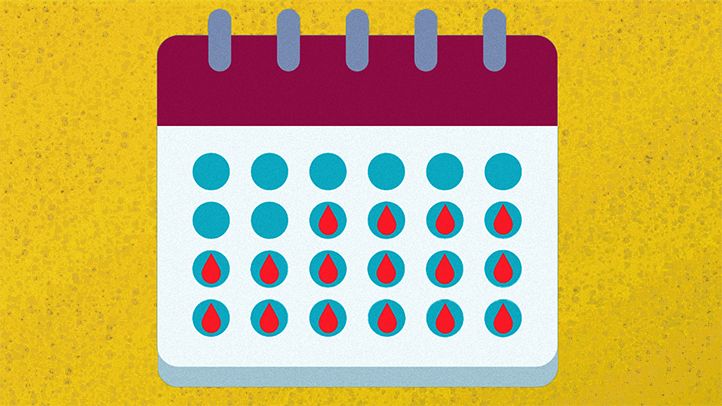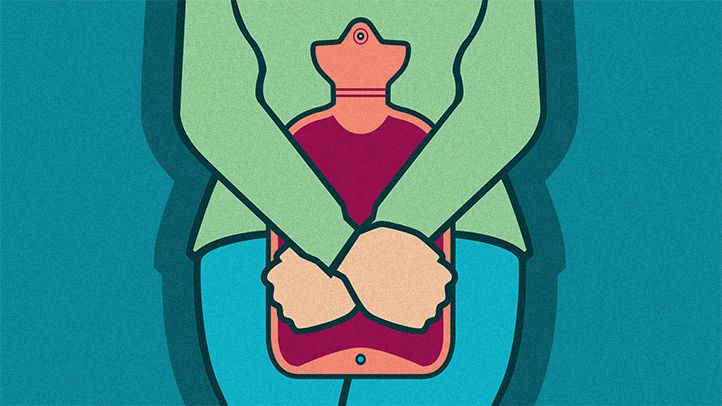Menstruation is the monthly bleeding associated with a woman's menstrual cycle.
The menstrual cycle is the series of hormonal changes that a woman's body goes through in preparation for pregnancy.
Each month, the lining of the uterus (or womb) thickens. Your body sheds this lining, along with blood, if no fertilized egg attaches to the wall of the uterus.
The blood and tissue pass out of the body through the vagina.
The menstrual period, or menstruation, typically lasts three to five days for most women.
Every woman's menstrual cycle is slightly different. A normal menstrual cycle length can be anywhere from 21 to 35 days. The average length of a menstrual cycle is 28 days.
Period Calculators
Many women track their menstrual cycles. If you're trying to become pregnant, keeping a record of your period can help you figure out when you're ovulating and whether your period is late.
Tracking periods can also help you spot any irregularities or changes to your menstrual cycle.
The U.S. National Institutes of Health (NIH) recommends marking each day of your period with an "X" on a calendar. Note any pain or changes in flow.
There are a number of websites and apps that offer free period trackers or period calculators.
Be aware, though, that many period-tracking apps have been found to be inaccurate, according to a June 2016 review in the journal Obstetrics and Gynecology.
Menstrual Cramps (Dysmenorrhea)
Dysmenorrhea, or menstrual cramping, is pain associated with menstruation.
Menstrual cramps are common. More than half of all women who menstruate report some pain for one to two days each month, according to the American College of Obstetricians and Gynecologists.
Hormones called prostaglandins can cause normal menstrual cramping. Prostaglandins are produced by the lining of the uterus.
Cramps usually occur right before menstruation starts and may last for a day or two. Pain typically decreases throughout the period as you shed the uterine lining.
See your doctor if pain gets worse as menstruation continues, doesn't go away after the end of the period, or is so severe that it affects your daily living. These may be signs of a more serious medical problem.
Irregular Periods
Certain menstrual cycle disorders can cause a woman's period to be irregular, absent, or infrequent:
Amenorrhea This term refers to the absence of periods for three to six months in a woman who has previously had periods or when menstrual periods haven't started by age 15.
Oligomenorrhea: This is a medical term for infrequent periods. Women with oligomenorrhea have fewer than six to eight periods in a year.
See your doctor if you miss more than three menstrual periods in a row, or three menstrual periods over the course of a year.
A number of conditions can cause irregular periods, including problems with the ovaries, uterus, cervix, vagina, or hormone-releasing centers in the brain.
Heavy Periods
Menorrhagia is the medical term for menstrual bleeding that lasts longer than normal or is very heavy.
Heavy periods can be a sign of other health problems. They also can lead to anemia (low red blood cell count, or lack of hemoglobin in the blood) from the increase in bleeding that occurs.
Talk to your doctor if:
- Your periods last longer than seven days
- Your menstrual flow soaks through one or more tampons (or pads) every hour for several hours in a row
- Your periods contain blood clots the size of a quarter or larger
- You're unusually tired or short of breath during your period
Most Recent In Menstruation
National Period Action Day Is October 9


Is Having Long Menstrual Bleeding Cause for Concern?


Is Your Period Normal?


See all in Menstruation


Editorial Sources and Fact-Checking
- Menstruation and the menstrual cycle fact sheet; Womenshealth.gov.
- C. K. Welt (2015). "Patient information: Absent or irregular periods (Beyond the Basics)." UpToDate.
- Dysmenorrhea: Painful Periods; American College of Obstetricians and Gynecologists.
- Moglia et al. (2016). "Evaluation of Smartphone Menstrual Cycle Tracking Applications Using an Adapted APPLICATIONS Scoring System." Obstetrics and Gynecology.

































